Conserving the Saint Martin Series: Technical Analysis of Fifteenth-Century Embroideries
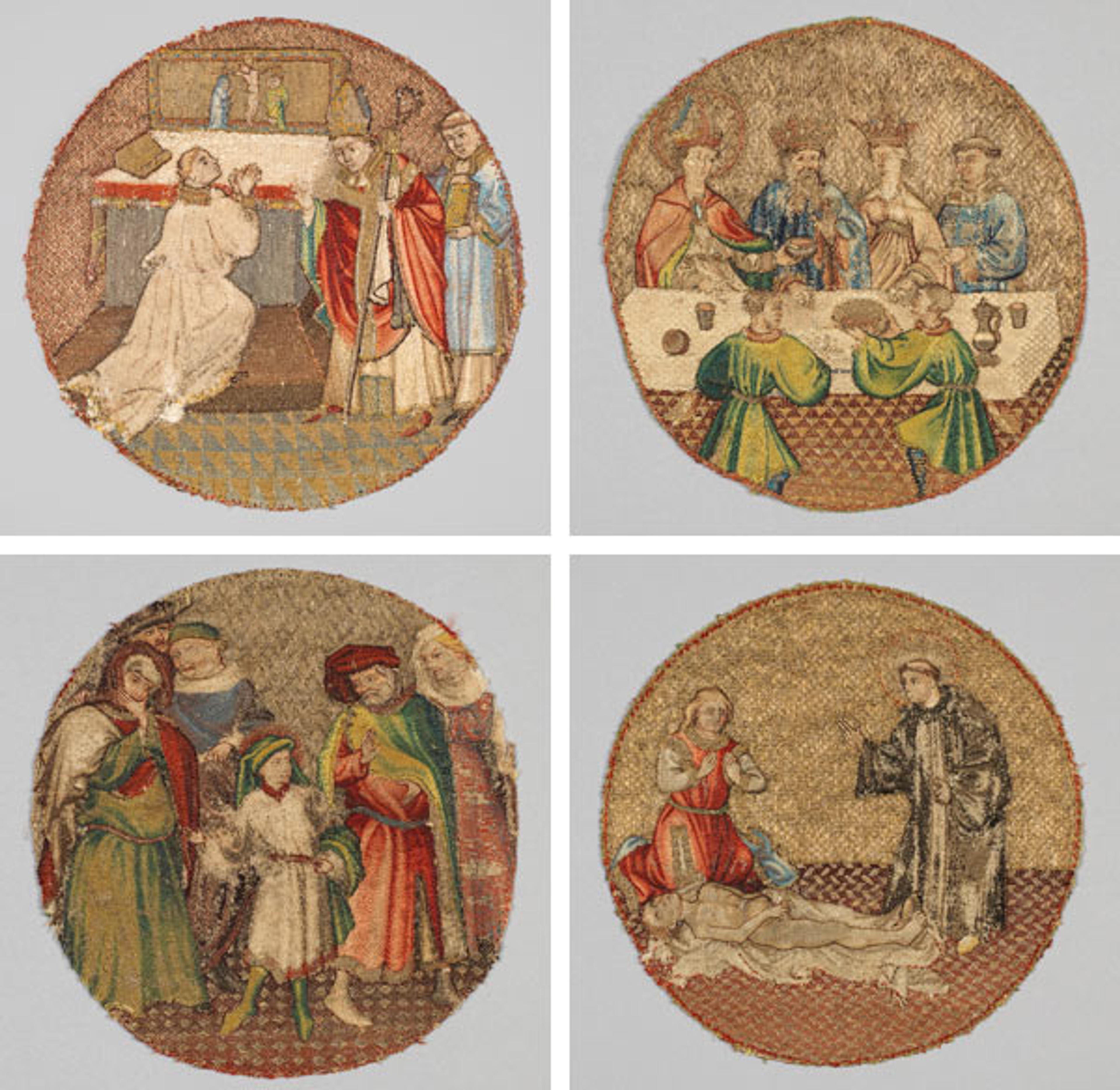
Four of the roundels, all from the Robert Lehman Collection (clockwise from top left: 1975.1.1908, 1975.1.1907, 1975.1.1909, 1975.1.1906), featured in the exhibition
«Seven embroideries, six roundels, and one arch panel depicting scenes from the life of Saint Martin are now on view in the exhibition Scenes from the Life of St. Martin: Franco-Flemish Embroidery from the Met Collection. These fifteenth-century textiles were embroidered with dyed silk, silver, and gilt–silver metal threads on a linen plain weave underlaid with two layers of linen plain weave (fig. 1).»

Fig. 1. Obverse (left) and reverse (right) of Saint Martin and Saint Hilary (1975.1.1908)
The sophisticated use of the silk and the delicate gilt–silver metal threads describes a technique called or nue', which was used primarily in Italy and Flanders. This technique implies the use of metal threads couched (or held in place) with dyed silk threads. Depending on the placement of the stitches, different patterns were created. The gilded metal strips were cut from a foil (a silver alloy containing ninety-five percent silver and five percent copper) previously gilded on one side, and then wrapped around a yellow silk core (fig. 2).

Fig. 2. Detail of the floor geometric pattern (magnified 2x) (left) and detail of the gilt–silver metal thread used in Saint Martin Offering the Wine Cup to the Priest (1975.1.1907) (right)
Gilt–silver metal threads were also used to create small design elements such as a bowl or cup. Laid down in parallel lines on a shaped padding underneath and stitched to the linen background at their extremities, they create a three-dimensional effect (fig. 3).

Fig. 3. Details of the bowl (magnified 1x and 5x) from Saint Martin Offering the Wine Cup to the Priest (1975.1.1907)
Technical examination using X-ray radiography shows the rich use of metal threads and the different ways they were applied, highlighting the original luxurious appearance of the embroideries and the embroiderer's skill with this sophisticated technique (fig. 4).
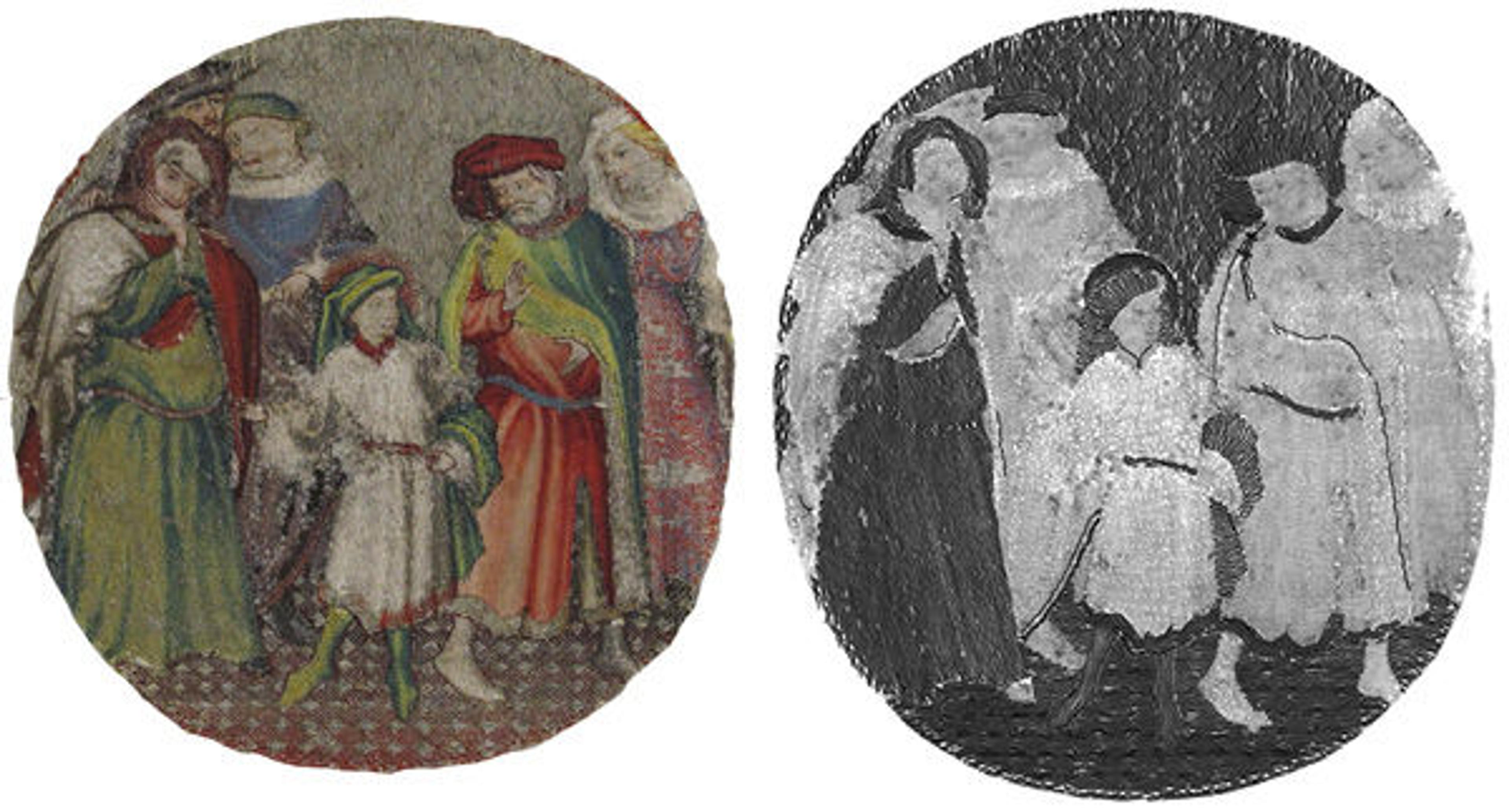
Fig. 4. Obverse of Saint Martin Announcing to His Parents That He Will Become a Christian (1975.1.1909) (left), and its radiography image (right)
While the silver and gilt–silver metal threads enhance the luxuriousness of the embroideries, the finely dyed silk threads create the fullness of each figure represented. A combination of gradations in the dyed satin, split and stem stiches in untwisted silk threads modulate the shades and emphasize the details of facial features and vestments, creating a needle-painted effect. Natural dyes, including red, yellow, and green hues made from madder root (Rubia tinctorum), weld (Reseda luteola), and, based on the date of the embroideries, a combination of weld and woad (Isatis tinctoria) were used to dye the silk threads, achieving a gradation in coloring (fig. 5).

Fig. 5. Detail of the green- and red-dyed silk stitches (magnified 5x), from Saint Martin Announcing to His Parents That He Will Become a Christian (1975.1.1909) (left) and Saint Martin Brings a Dead Man to Life (1975.1.1906) (right)
The condition of the seven embroidered roundels in the Saint Martin series is good, although they show evidence of use, as they were once part of an ecclesiastic vestment ensemble (fig. 6).
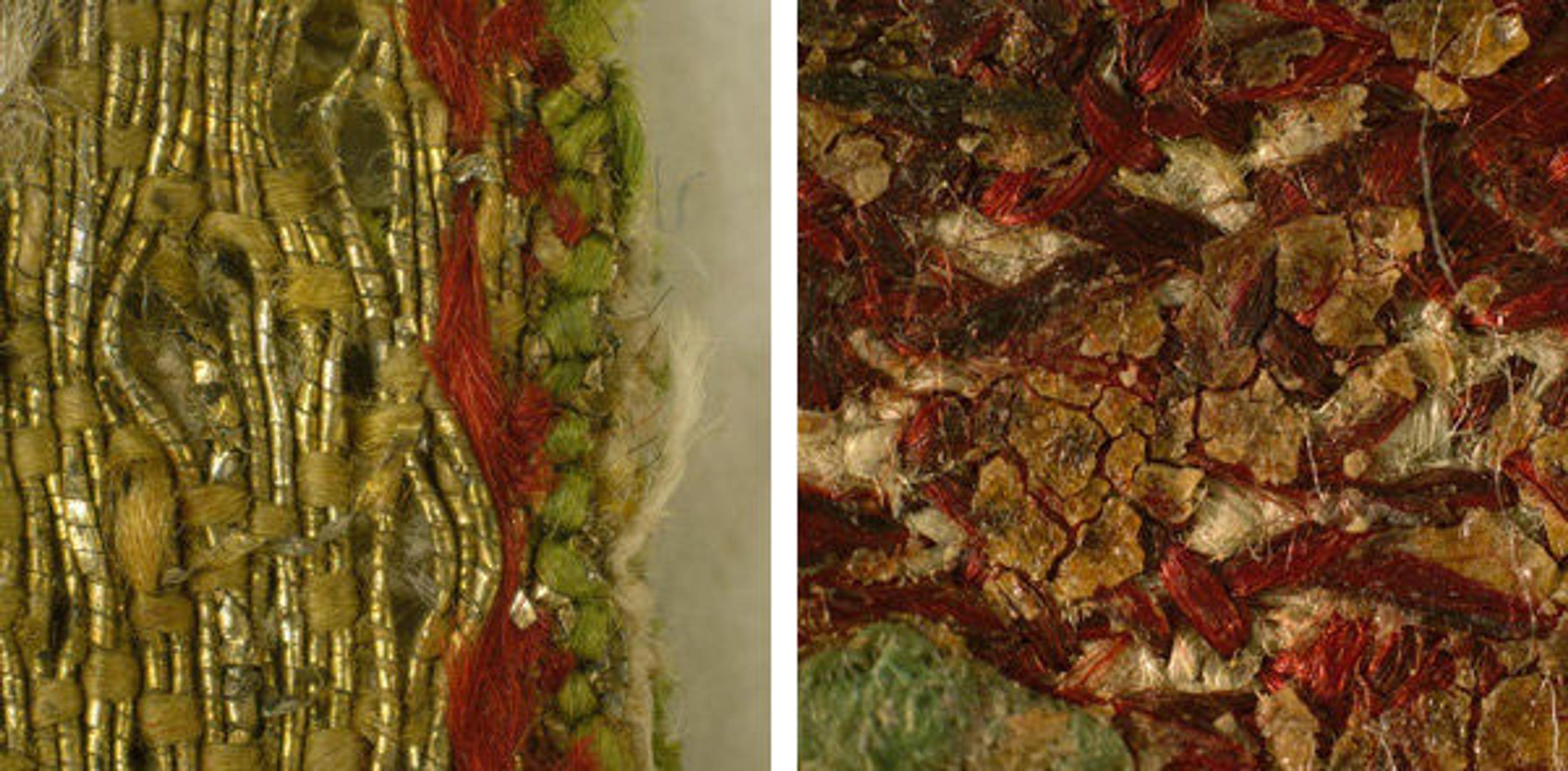
Left: Fig. 6. This magnified detail of the roundel's edge (magnified 5x) from Saint Martin Brings a Dead Man to Life (1975.1.1906), showing red and green silk thread stitches, suggests evidence of its original boundary or previous application to a vestment. Right: Fig. 7. Detail of the reverse surface of Saint Martin Brings a Dead Man to Life (1975.1.1906)
During previous restoration treatments performed prior to the objects entering the Museum's collection, patches of linen fabric were applied to their reverse to support worn areas (fig. 1, right). The reverse of each piece was covered with starch paste to stiffen the linen weave structure. In the long term, this treatment affected the condition of the embroidery's ground fabric, forming a brittle surface (fig. 7).
In a few areas, the thin gilded–silver metal strips show damage due to abrasion and oxidation, leaving the yellow silk core exposed, while the loss of the fine silk embroidery threads affected the original fullness of each figure (fig. 8).
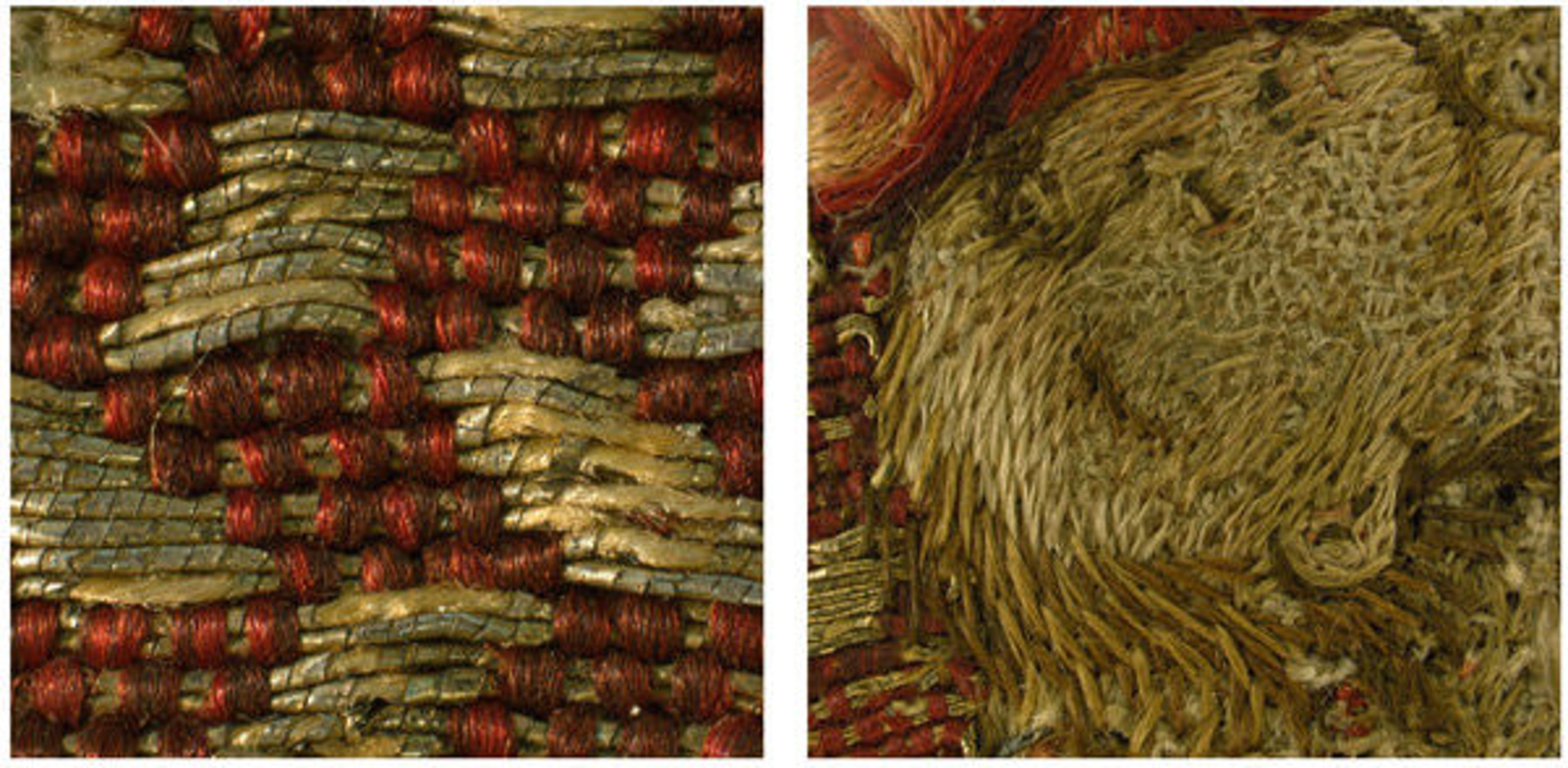
Fig. 8. Detail of the damaged gilt–silver metal strip (left), and of the facial features embroidered with silk (magnified 1x) from Saint Martin Brings a Dead Man to Life (1975.1.1906) (right)
In an attempt to recreate the appearance of a completely lost area of embroidery, silk floss was aligned in parallel rows and couched with different gradations of colored silk thread (fig. 9).
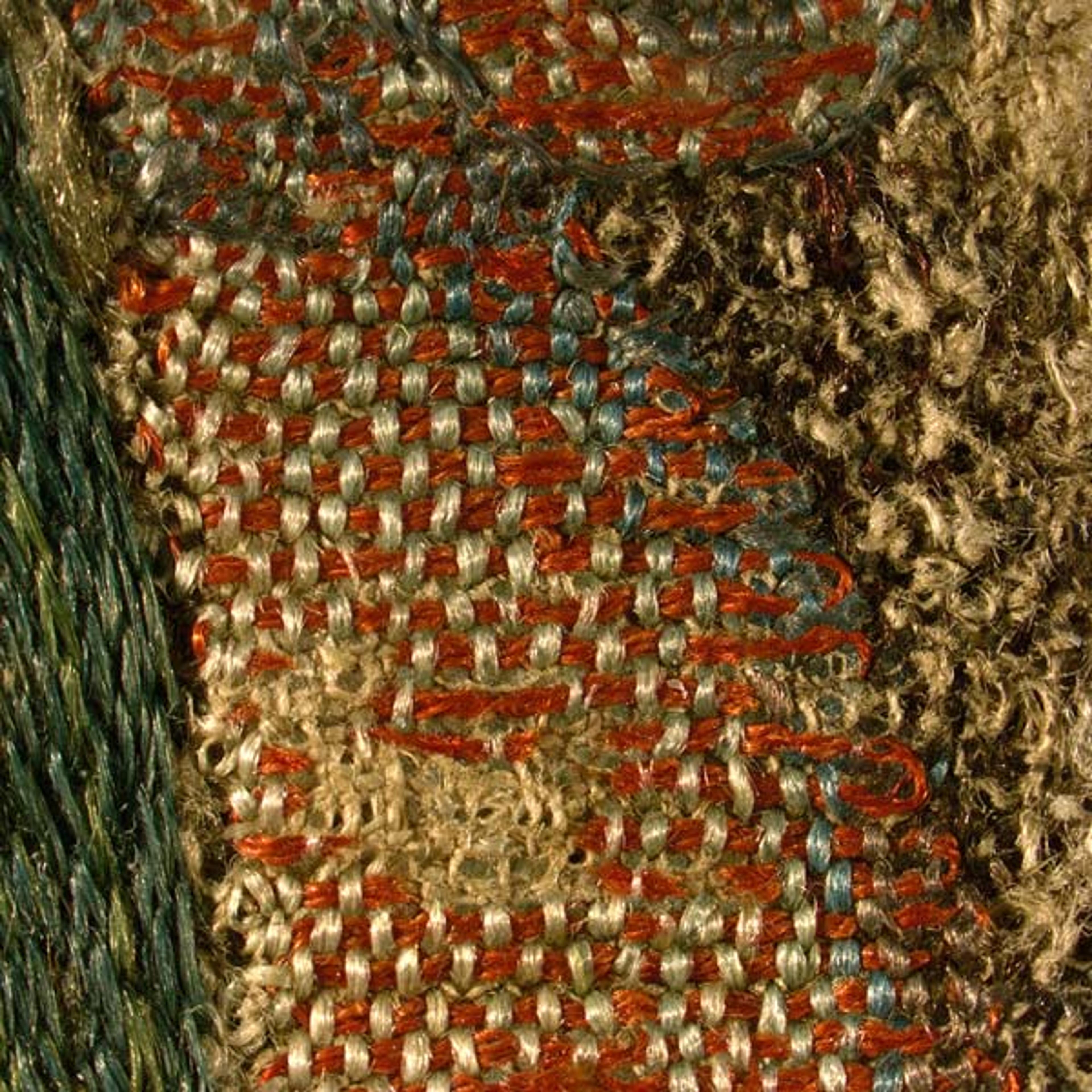
Left: Fig. 9. Detail of a previous restoration treatment for Saint Martin Announcing to His Parents That He Will Become a Christian (1975.1.1909)
In preparing these object for display in this exhibition, none of the previous restoration treatments were removed. Following the configuration of the original pattern, loose metal threads were realigned and couched to the linen ground with a neutral-colored cotton thread.
To display these objects, the roundels were placed on slanted boards made of archival material covered with cotton fabric, a method that allows visitors to see the reverse of each of the roundels for study purposes. The placement of the embroideries in a vitrine keeps the pieces at a secure, ambient environmental condition throughout the duration of the exhibition.
The author wishes to thank Cristina Carr, conservator in the Department of Textile Conservation, for her assistance in taking the X-ray images. In the Department of Scientific Research, the author also wishes to thank Associate Research Scientist Nobuko Shibayama for providing dye analysis; Associate Research Scientist Federico Carò for providing the metal thread analysis; as well as Associate Research Scientist Adriana Rizzo and intern Meghan Schwab for providing paste identification.
Related Link
Scenes from the Life of St. Martin: Franco-Flemish Embroidery from the Met Collection, on view May 11–October 25, 2015
Banner image (clockwise from top left): Saint Martin and Saint Hilary, 1430–35. Flanders. Linen plain weave underlaid with linen plain weave (two layers) and embroidered with silk and gilt-metal-strip-wrapped silk in single satin, split, and stem stitches, laid work, and couching, including or nué; Diameter (above measurement of mount opening): 6 1/2 in. (16.5 cm). The Metropolitan Museum of Art, New York, Gift of Robert Lehman, 1975 (1975.1.1908). Saint Martin Offering the Wine Cup to the Priest, 1430–35. Flemish. Linen plain weave underlaid with linen plain weave (two layers) and embroidered with silk and gilt-metal-strip-wrapped silk in single satin, split, and stem stitches, laid work, and couching, including or nué; Diameter (above measurement of mount opening): 6 1/2 in. (16.5 cm). The Metropolitan Museum of Art, New York, Gift of Robert Lehman, 1975 (1975.1.1907). Saint Martin Brings a Dead Man to Life, 1430–35. Flemish. Linen plain weave underlaid with linen plain weave (two layers) and embroidered with silk and gilt-metal-strip-wrapped silk in single satin, split, and stem stitches, laid work, and couching, including or nué; Diameter (above measurement of mount opening): 6 1/2 in. (16.5 cm). The Metropolitan Museum of Art, New York, Gift of Robert Lehman, 1975 (1975.1.1906). Saint Martin Announcing to His Parents That He Will Become a Christian, 1430–35. Flemish. Linen plain weave underlaid with linen plain weave (two layers) and embroidered with silk and gilt-metal-strip-wrapped silk in single satin, split, and stem stitches, laid work, and couching, including or nué; Diameter (above measurement of mount opening): 6 1/2 in. (16.5 cm). The Metropolitan Museum of Art, New York, Gift of Robert Lehman, 1975 (1975.1.1909).
Giulia Chiostrini
Giulia Chiostrini is an assistant conservator in the Department of Textile Conservation.